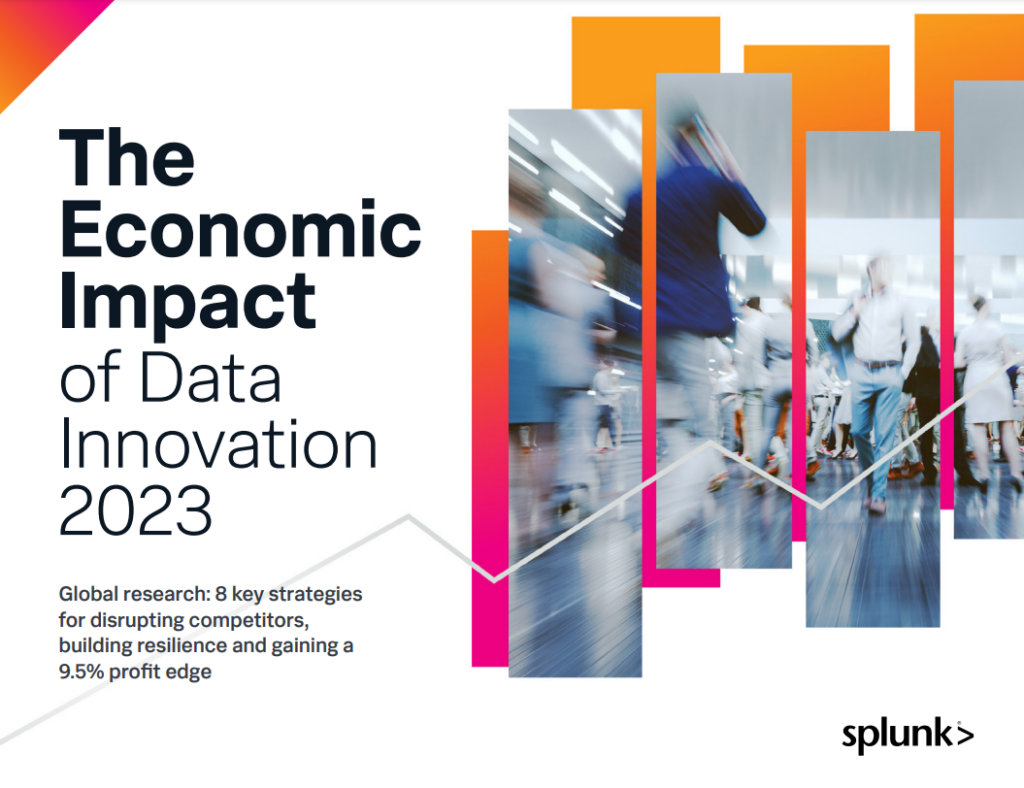Does an investment in data innovation drive real, monetary results?
That was the question driving Splunk’s latest research endeavor, The Economic Impact of Data Innovation 2023.
By surveying over 2,000 organizations worldwide, researchers discovered that mature data practices allow organizations to increase profits by nearly 10%, get a leg up on competition, and drive significant business outcomes across the board.
In this article, we’ll break down the top takeaways from the report including:
-
- Seven advantages data leaders have over competitors
- Eight actionable steps your organization can take to become a data leader
But before we get started, let’s first define what a data leader is.
What is a Data Leader?
Researchers assessed the data practices of all 2,000+ participating organizations and placed them into three categories: data leaders, intermediates, and beginners.
Data leaders are defined as organizations that have “achieved excellence” in the following key data areas:
-
- Classification
- Aggregation
- Quality
- Analysis skills
- Analysis tools
- Monitoring
Intermediates are defined as organizations that have achieved excellence in three to five of these areas, and beginners are defined as organizations that have achieved excellence in zero to two areas.
7 Advantages Data Leaders Have Over Beginners and Intermediates
Compared to beginners and intermediates, data leaders report advantages across the board.
Here are seven of the most relevant ones.
1. Data Leaders Experience Increased Profits
Data leaders reported a 9.5% edge in gross profits over data beginners. They also exceeded earnings targets at twice the rate, and they were 5x as likely to increase sales win rates by 10% or higher.
2. Data Leaders Outpace Their Competitors
Data leaders were 3x as likely to report that they regularly beat competitors to market, and they did so by an average of one year.
Additionally, they were 5x as likely to believe that their organization is in a strong position to compete in its markets over the next few years and 6x as likely to say their organization almost always makes better decisions than its competitors.
3. Data Leaders Drive More Revenue From New Products
On average, data leaders reported launching nine products per year that wouldn’t have been possible without advanced data capabilities. That’s 3x the number reported by beginners.
Because of this, data leaders were 5x as likely to report driving more than 20% of their revenue from new products and services launched in the last year.
4. Data Leaders Improve Customer Experience and Increase Upselling
Advanced data practices allow organizations to better understand their customers and build a better customer experience. Compared to beginners, data leaders experience:
-
- Greater brand loyalty (48% of leaders versus 30% of beginners)
- Increased customer lifetime value (49% versus 30%)
- Improved customer satisfaction (53% versus 43%)
- Increased positive word of mouth (45% versus 22%)
- Higher conversion of low-value customers to high-value customers (52% of customers versus 33%)
5. Data Leaders Excel in Data Monetization
Another way data innovators succeed is in getting more value out of data itself.
98% of leaders reported monetizing their data, compared to 65% of beginners. Additionally, leaders reported more profits, growth, and differentiation in their data monetization revenue streams than beginners.
6. Data Leaders Better Optimize the Supply Chain
Advanced data practices allow leaders to better optimize the supply chain, with 79% of leaders reporting reduced costs and 73% reporting reduced disruptions.
Compared to beginners, data leaders reduce costs at 2.5x the rate.
7. Data Leaders Are More Optimistic and Resilient
Leaders are 5x as likely to believe their organization is a good place to beat out competition, 6x as likely to believe they make better decisions than their competitors, and 2x as likely to overshoot earnings targets.
Leaders are also 11% more effective in managing disruptions and setbacks.
8 Ways to Become a Data Leader
Clearly, being a data leader comes with serious advantages.
But what exactly makes a leader, and how can aspiring organizations become one?
Here are eight characteristics researchers found to be key of data leaders.
1. Prioritize Data Innovation
Being a data leader means making data innovation a top priority.
60% of surveyed leaders said that bettering their use of data is their number one priority for the next 24 months — only 13% of beginners said the same.
2. Invest for Success
You have to spend money to make money.
Data leaders allocate 53% more of their technology budget to data innovation than beginners. They also continuously invest in new technologies like cloud analytics, AI/ML, and observability.
3. Bring Innovation to the Executive Level
Data leaders bring data innovation to the C-suite, with 90% of leaders having C-level roles around data governance, strategy, and innovation. Beginners are 24 to 33 points less likely to have these roles.
4. Establish a Center of Excellence
Leading organizations build centralized, rather than distributed, teams. 57% of leaders say they always rely on centers of excellence, compared to 15% of beginners.
5. Prioritize Tech-Centric Data Streams
When asked which data sources they give the most attention, leaders were more likely to cite tech-oriented data — network data, application data, etc. — than beginners. Beginners focused mainly on customer and sales data.
6. Pivot to “Know Your Customer” Data Next
Despite their focus on tech-oriented data, leaders don’t neglect the value of human-centric data.
Leaders were 6% more likely than beginners to cite customer data as having the most potential down the road, 9% more likely to cite sales data, and 11% more likely to cite business service transaction and performance data.
7. Commit to Either Speed or Market Fit When it Comes to Product Innovation
Beginner and intermediate organizations were more likely to report trying to balance innovating as quickly as possible with doing as much market research as possible.
Only 28% of leaders took this split approach, however. Instead, they opted to prioritize one area over the area.
8. Cultivate a Broader Sense of Paranoia
Leaders were more likely to worry about competitive threats than beginners, specifically about growing startups and the sudden onset of enterprise-class competition.
With this worry, however, comes increased action. As Splunk puts it, “vigilance is the price of leadership.”
Become a Data Leader With SP6
At SP6, we’re committing to helping organizations better leverage their data. To find out how we can help you become a data leader, schedule a consultation with us today.
———
SP6 is a niche technology firm advising organizations on how to best leverage the combination of big data analytics and automation across distinct (3) practice areas:
-
- Cybersecurity Operations and Cyber Risk Management (including automated security compliance and security maturity assessments)
- Fraud detection and prevention
- IT and DevOps Observability and Site Reliability
Each of these distinct domains is supported by SP6 team members with subject matter expertise in their respective disciplines. SP6 provides Professional Services as well as ongoing Co-Managed Services in each of these solution areas. We also assist organizations in their evaluation and acquisition of appropriate technology tools and solutions. SP6 operates across North America and Europe.


